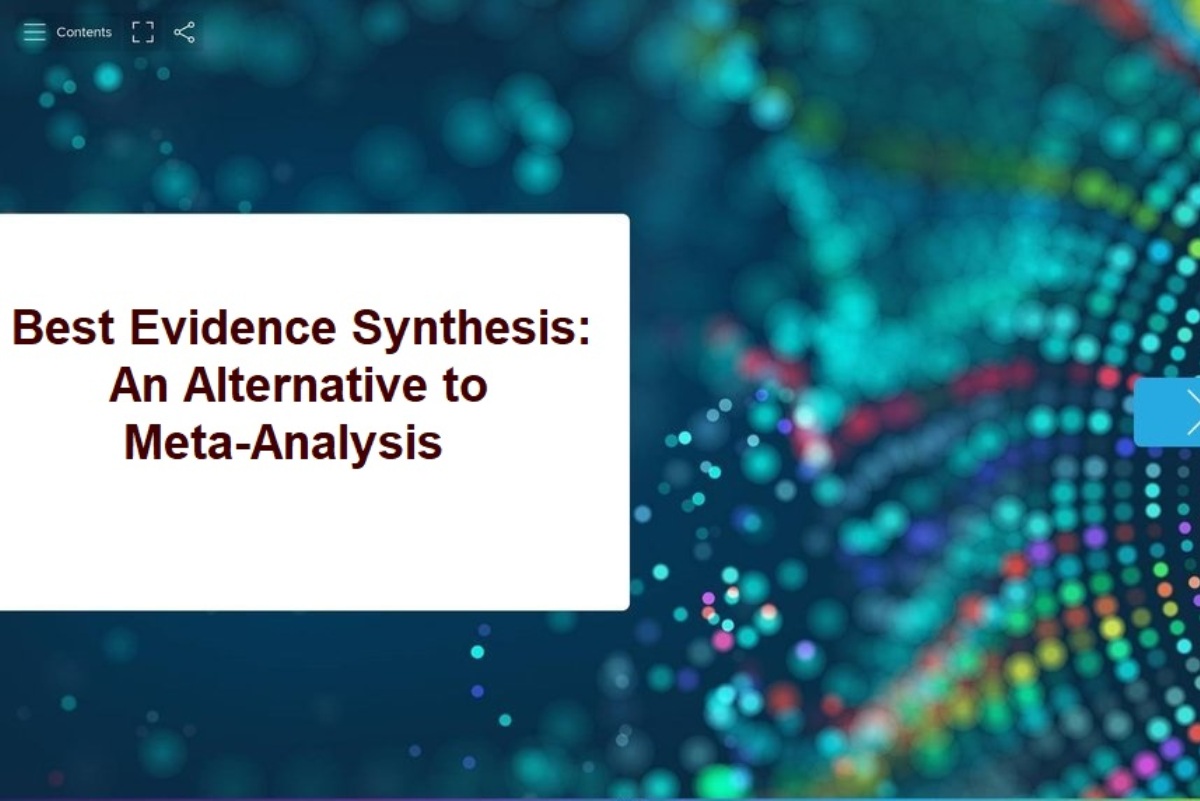Best Evidence Synthesis (BES) represents a sophisticated, context-sensitive alternative to meta-analysis, combining qualitative and quantitative research to form nuanced conclusions.
Best Evidence Synthesis addresses the shortcomings of traditional meta-analysis by prioritizing study quality, methodological rigor, and contextual relevance. This method excels in fields with diverse research designs, offering a comprehensive synthesis of evidence that is adaptable and applicable in various settings.
Challenges in Meta-Analysis
Meta-analysis, while invaluable for aggregating quantitative data, often struggles with several key issues:
-
Homogeneity Requirement: Meta-analysis is most effective when synthesizing studies that are relatively homogeneous in design, methodology, and outcomes. Variability among studies can lead to misleading results or inappropriate generalizations.
-
Publication Bias: The tendency to publish studies with significant results leads to a biased synthesis, where studies with null or negative results are underrepresented.
-
Quantitative Emphasis: Meta-analysis primarily focuses on statistical aggregation, potentially overlooking the qualitative aspects that could provide a deeper understanding of the data.
-
Contextual Oversimplification: Meta-analysis often reduces the richness of study contexts in pursuit of statistical power, which can result in conclusions that are not universally applicable.
Best Evidence Synthesis: A Solution
Best Evidence Synthesis overcomes these challenges by integrating qualitative insights and emphasizing the importance of context in evidence synthesis:
-
Quality Over Quantity: Best Evidence Synthesis prioritizes high-quality studies with robust methodologies, providing a more accurate synthesis. Studies with significant methodological flaws are excluded or carefully contextualized to prevent skewed results.
-
Contextual Relevance: Best Evidence Synthesis takes into account the specific context of each study, making the synthesis applicable to different settings and populations. This approach is especially useful in fields like healthcare and education, where local factors can significantly impact outcomes.
-
Qualitative Data Integration: Best Evidence Synthesis incorporates qualitative findings, enhancing the understanding of complex phenomena that cannot be fully captured by quantitative data alone.
-
Narrative Synthesis: Best Evidence Synthesis uses narrative synthesis techniques to create a coherent storyline that integrates both qualitative and quantitative evidence, offering a comprehensive and accessible overview of the research.
Methodological Approach
The Best Evidence Synthesis process is systematic and involves several key steps:
-
Literature Review: A systematic review of the literature identifies studies that meet stringent inclusion criteria, focusing on quality and relevance.
-
Study Evaluation: Each study is critically evaluated based on methodological rigor, relevance, and context. This evaluation considers factors such as study design, sample size, and analytical techniques.
-
Data Synthesis: Best Evidence Synthesis synthesizes quantitative data using statistical methods, supplemented by qualitative data and narrative synthesis to provide a comprehensive view of the evidence.
-
Weighting of Evidence: In Best Evidence Synthesis, studies are weighted according to their quality and relevance, ensuring that the synthesis reflects the best available evidence.
-
Presentation of Findings: Best Evidence Synthesis presents findings in a way that emphasizes both the strength and context of the evidence, making the conclusions more relevant to policy and practice.
Applications of Best Evidence Synthesis
Best Evidence Synthesis is particularly valuable in fields characterized by diverse and complex research, such as education, healthcare, and social sciences. In these areas, traditional meta-analysis often struggles to accommodate the variability in study designs and contexts.
For example, in educational research, Best Evidence Synthesis can identify effective teaching strategies by considering contextual factors such as student demographics, classroom environments, and teacher experience. In healthcare, Best Evidence Synthesis can provide insights into the effectiveness of treatments across different patient populations and healthcare settings.
Advantages of Best Evidence Synthesis
-
Robust Conclusions: Best Evidence Synthesis produces more reliable conclusions by emphasizing study quality and context, reducing the risk of drawing misleading inferences from flawed studies.
-
Flexibility: Best Evidence Synthesis is adaptable to a wide range of study designs and methodologies, making it suitable for fields with diverse research traditions.
-
Comprehensive Understanding: By integrating qualitative data, Best Evidence Synthesis offers a deeper understanding of the evidence, allowing for the exploration of underlying mechanisms and contextual factors.
-
Policy and Practice Relevance: The findings generated by Best Evidence Synthesis are often more directly applicable to policy and practice, as they consider the specific contexts in which the evidence is to be applied.
How Meta-Analysiss.com Can Enhance Best Evidence Synthesis
Meta-Analysiss.com provides advanced tools and resources to support the Best Evidence Synthesis process, particularly in the following ways:
-
Study Selection and Evaluation: Meta-Analysiss.com offers robust features for systematic literature reviews, enabling researchers to efficiently identify and evaluate relevant studies based on stringent criteria.
-
Data Synthesis Tools: The platform provides sophisticated statistical tools for synthesizing quantitative data, while also supporting the integration of qualitative findings into a cohesive narrative synthesis.
-
Weighting and Contextual Analysis: Meta-Analysiss.com allows researchers to assign weights to studies based on quality and relevance, ensuring that the Best Evidence Synthesis reflects the best available evidence. It also offers features for contextual analysis, helping to maintain the richness of the original studies.
-
Visualization and Reporting: The platform includes tools for visualizing data and generating comprehensive reports, making it easier to communicate findings to stakeholders in a clear and accessible manner.
By leveraging the capabilities of Meta-Analysiss.com, researchers can enhance the effectiveness of Best Evidence Synthesis, ensuring that their evidence synthesis is both rigorous and contextually relevant.
Conclusion
Best Evidence Synthesis offers a powerful alternative to traditional meta-analysis, combining qualitative and quantitative data to produce a comprehensive and nuanced synthesis of evidence. By emphasizing study quality, contextual relevance, and the integration of qualitative insights, Best Evidence Synthesis provides robust and reliable conclusions that are directly applicable to policy and practice. The tools and resources provided by Meta-Analysiss.com further enhance the Best Evidence Synthesis process, making it more efficient, accurate, and contextually appropriate for diverse research fields.





